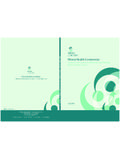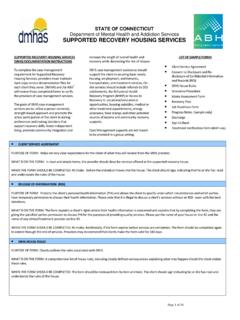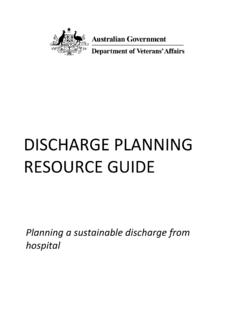Transcription of Best Practices in the Discharge Process What Do …
1 The Satisfaction Snapshot is a monthly electronic bulletin freely available to all those involved or interested in improving the patient/client experience. Each month the Snapshot showcases issues and ideas which relate to improving patient satisfaction and customer service, improving workplace culture and improving the way we go about our work in the healthcare Satisfaction Snapshot features: relevant articles from healthcare industry experts case study success stories tips and tools for quality improvement patient satisfaction and other industry research findings articles with ideas to help achieve success in your roleIf you would like your colleagues to receive the Satisfaction Snapshot please send us their names and email addresses. The Satisfaction Snapshot is published by Press Ganey Associates Pty Ltd.
2 All material is copyright protected. Quotation is permitted with attribution. Subscribers are permitted and encouraged to distribute copies within their to the Satisfaction Snapshot is FREE!Please direct any comments, suggestions or article submissions to:Sharon KerrManager of Client 07 5560 7400F: 07 5531 5390 best Practices in the Discharge Process What Do Patients Want, What are They Getting,and What s Working? Paul Alexander Clark, MPA, CHE, Senior Knowledge Manager, Press Ganey AssociatesEdited by Terry Grundy, MBA, Director of Client Services, Press Ganey AssociatesWhat Do Patients Want in the Discharge Process ? Truly suffering from the illness experience, patients and their families need every interaction to support, affirm, and help them on their road to recovery. Or help improve their physical, mental, and emotional pain when recovery is not possible.
3 This means evaluating and designing every Process with this in mind. Specifically, within the Discharge Process , patients want:To have their follow-up and home care seamlessly arranged;To know when they will be going home and what they have to go through on the day of Discharge ;To feel safe to feel like they are ready and prepared to go home (or transition elsewhere);To have the information needed to have true confidence in their feeling of preparedness for going home and caring for themselves in the days after Discharge ;To have a convenient, easy, fast, and pain-free transition from their hospital bed to their home;To have all their questions answered, their feelings considered, their family involved, enough flexibility in the Process to adjust to their individual needs, and a continuous healing relationship with the care achieve this, a facility must provide effective and respectful communication to nurses, doctors, and anyone else that interacts with patients and their family members.
4 News, views & ideas from the leader in healthcare satisfaction measurementIn addition to general informational needs, clinically-related educational needs are also not properly addressed. A 2000 survey study revealed that over 50% of patients with a stay of 5 days or less failed to receive information on side effects, recovery at home, or community health services (Rowe et. al.). Jones et. al. (1989) found that 81% of patients needing assistance with basic functional needs failed to receive home care referrals and 64% of these patients reported that no one at the hospital had talked to them about managing at home. In addition, a post- Discharge follow-up study found that 50% of patients dependent upon others for basic functional needs failed to receive home care referrals (Rosswurm & Lanham 1998). In a study by Bowles et. al. (2002), more than 56% of patients discharged did not receive a home care referral despite being screened into the study on the basis of this need and being at risk for poor Discharge outcomes 96% of this subset of patients had unmet Discharge needs.
5 Such studies confirm observations that, as a side effect of health care consumerism, patients and families have assumed greater direct responsibility for their own care; care which is often complex and dangerous (Morrison 2000).Patients post- Discharge care needs, usually undertaken by families, range from errands and household chores to basic, functional needs ( , bathing, getting dressed) to nontrivial medical needs ( , changing dressings, wound care, help with physiotherapy regimens) (Wolock et. al. 1987). The majority of caregivers care for patients personal needs following hospitalisation, and three-quarters of these individuals assume responsibility for 5 or more tasks ( , preparing meals, administering medication) (DesRoches et. al. 2002). Caregivers frequently do not feel adequately prepared to assume these responsibilities (Leske & Pelczynski 1999).
6 Patients and families who do receive hospital Discharge planning, counselling, home care referrals, and other social interventions often do not find these interventions beneficial, which indicates that how these are implemented makes a difference (Jackson 1994; vom Eigen et. al. 1999). Post-hospital needs for care, assistance, and information ( , activity limitations) persist (Otkay et. al. 1992; Mamon et. al. 1992) when Discharge instructions are not implemented as planned (Proctor et. al. 1996) and home care services unexpectedly terminate within a few weeks after Discharge (Simon et. al. 1995). Nurses routinely underestimate patients needs at Discharge , overestimate the quality and amount of education and information provided, and fail to discern the same needs that patients and caregivers find important (Rose, Bowman & Kresevic 2000).
7 What are Patients Getting? Recent studies have substantially increased the body of knowledge and understanding of patients informational and educational needs in preparation for Discharge (Bubela et. al. 1990; Bostrom et. al. 1994; Armitage & Kavanagh 1998; Lithner & Zilling 2000; Burney, Purden & McVey 2002; Gustafson et. al. 2001; Jones, Burney & Christy 2000; Reiley et. al. 1996). Patients desire information on follow-up, home care, symptom management, pain management, and coping with potential health problems (Armitage & Kavanagh 1998; Lithner & Zilling 2000; Burney, Purden & McVey 2002). Patients want specific written information and resources on follow-up and community services (Lithner & Zilling 2000; Reiley et. al. 1996), pain treatment (Lithner & Zilling 2000; Burney, Purden & McVey 2002), and life activities (Lithner & Zilling 2000) ( , What can or cannot be done ).
8 In fact, Gustafson et. al. (2001) found that information and support needs of patients outweighed care delivery needs and service the value and demand for this information, between 27%-80% of patients do not receive the desired amount of information (Burney, Purden & McVey 2002; Jones, Burney, & Christy 2000; Mistiaen et. ). page 2 SATISFACTION snapshotPre-admission phone calls and videos improve the Discharge processAt one facility, before admission, patients who will be receiving common procedures receive a brief DVD video that walks them through the unit, surgery, recovery, and introduces the nurses. The preadmission department calls each patient ahead of time to confirm that the video has been watched and to answer any questions. Patients who have not viewed the video are flagged for educational counselling on the morning of admission and additional time is built into the early with preadmission or preoperative educationBefore patients come in for surgery at another facility they view a 10-minute video that shows exactly where the patient is going to go, what the wounds will look like, etc.
9 Patients may take this video home to review as facility provides a pre-surgical home care visit for hip replacement patients that includes instructions on how to perform movement exercises that are hard to teach post-surgery. Deep breathing exercises are also is likely that the Discharge Process is the final impression the hospital and staff will imprint on patients and family members. A good experience leaves the patient with positive emotions and a strong affinity for returning to the facility (as we will see, satisfaction with aspects of the Discharge Process are well-correlated with patient loyalty). A negative experience can override good impressions and positive consideration developed throughout the hospital stay. Discharge represents the moment of truth when patients and family see whether they are actually cared for as a person or viewed as just another bed occupant that needs to be streeted as quickly as for Improving the Discharge Process Finally, since organisational support for service and quality improvement projects generally result, in large part, from senior executives perception of the program s payoffs, the benefits of patient satisfaction in this context deserve review.
10 Improving patient throughput results in reduced length-of-stay, increased efficiency, and operating effectives all of which improve the bottom line ( , increased return-on-assets). Additionally, patient perceptions of the quality of the Discharge Process substantially impact a hospital s financial outcomes through increased staff retention, patient loyalty or propensity-to-return. As a dimension of hospital quality, Discharge is significantly related to earnings per bed (p < ). For earnings per bed, the dollar amount associated with a one point gain or loss in satisfaction ( , moving from an average rating of good (3 points) to very good (4 points)) for this dimension of quality is $4, (Nelson et. al. 1992). Recognition of this and the powerful bond between overall patient satisfaction and patient loyalty (Peltier et. al. 2002; John 1994; Ware, Jr.)






